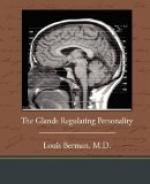INTERNAL SECRETION VARIETIES
There is no better way of illustrating the influence of the internal secretions upon the normal than the analysis of the variation of traits with variations in glandular predominances. The general build of an individual, his skeletal type, the proportion between the size of his arms and that of his legs, as well as that between his trunk and his lower extremities, whether he is to be tall, lanky and loutish, or short, squat and dumpy, are to be considered. Different facial types are the expressions of underlying endocrine differences. The head and skull offer a number of clues to the controlling secretions in the blood and tissues. Whether the forehead is to be broad or narrow, the distance between the eyes, the character of the eyebrows, the shape and size and appearance of the eyes themselves, the mould of the nose and jaws and the peculiarities of the teeth, are all so determined. The skin, in its color, texture, the quantity and distribution of its fatty and other constituents, eruptions and weather reactions, is influenced. Also the mucous membranes, the color and lustre and structure of the hair, as well as its general distribution and development, are hieroglyphics of the endocrine processes below the surface. Whether the muscles are massive or sparse, atrophied or hypertrophied, soft or hard, easily fatigable or not, bespeak conditions in the glandular chain. In short, we must regard the individual as an immensely complicated pattern of designs traced by the hormones as the primary etchers of his development. Though it must be admitted that the number of unknown and unsolved relations in the pattern are still enormously great, enough has been established to make possible a rough working analysis of the particular, unique organism placed before us for examination as Mr. Smith, Mrs. Jones, or Miss Smith-Jones.
WHAT IS THE NORMAL?
Anthropologists, from the beginning of anthropology, have battled in vain for a satisfactory inclusive definition, or, at least, description of the normal. With the introduction of the biometric method, the goal at last appeared within sight. A cocked hat curve expressing the distribution and range of the normal looks formidable. The attainable turned out a mirage, for the curves constructable by the measurement of traits of a population only proved the truth of the old axiom that all transitions and variations between extremes exist. The Problem of the Normal seemed more elusive than ever. And the best that could be done for the elucidation of its mystery, was to apply and observe the law of averages.




